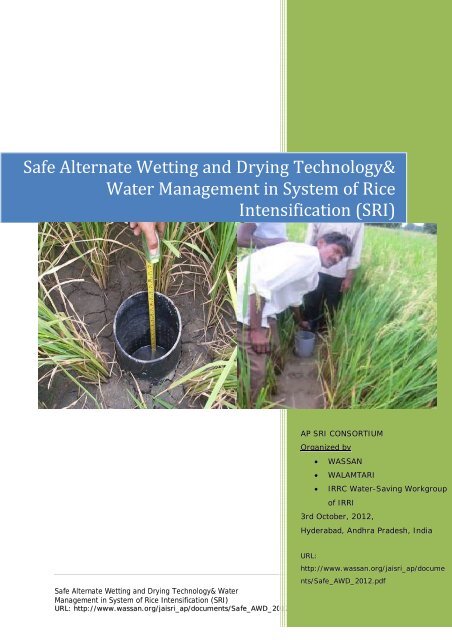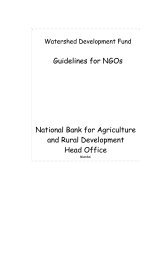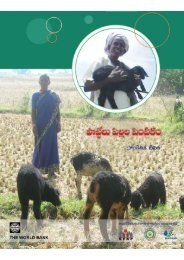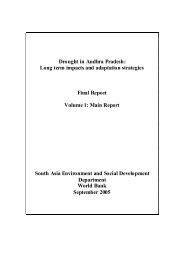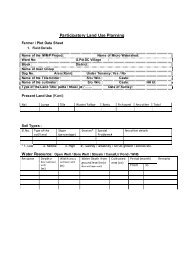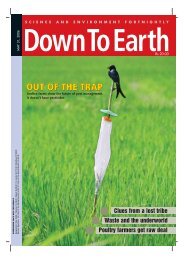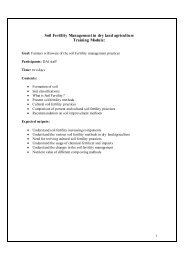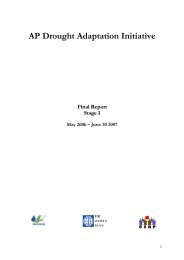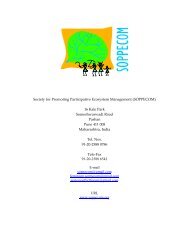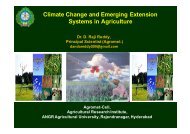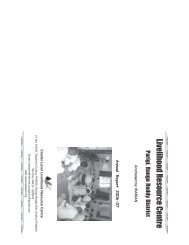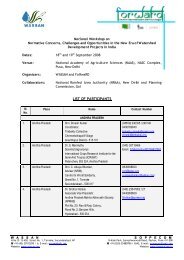Safe Alternate Wetting and Drying Technology& Water ... - WASSAN
Safe Alternate Wetting and Drying Technology& Water ... - WASSAN
Safe Alternate Wetting and Drying Technology& Water ... - WASSAN
You also want an ePaper? Increase the reach of your titles
YUMPU automatically turns print PDFs into web optimized ePapers that Google loves.
<strong>Safe</strong> <strong>Alternate</strong> <strong>Wetting</strong> <strong>and</strong> <strong>Drying</strong> Technology& <strong>Water</strong>Management in System of Rice Intensification (SRI)URL: http://www.wassan.org/jaisri_ap/documents/<strong>Safe</strong>_AWD_2012.pdf5 | P age
<strong>Safe</strong> <strong>Alternate</strong> <strong>Wetting</strong> <strong>and</strong> <strong>Drying</strong> Technology& <strong>Water</strong>Management in System of Rice Intensification (SRI)URL: http://www.wassan.org/jaisri_ap/documents/<strong>Safe</strong>_AWD_2012.pdf6 | P age
<strong>Safe</strong> <strong>Alternate</strong> <strong>Wetting</strong> <strong>and</strong> <strong>Drying</strong> Technology& <strong>Water</strong>Management in System of Rice Intensification (SRI)URL: http://www.wassan.org/jaisri_ap/documents/<strong>Safe</strong>_AWD_2012.pdf7 | P age
<strong>Safe</strong> <strong>Alternate</strong> <strong>Wetting</strong> <strong>and</strong> <strong>Drying</strong> Technology& <strong>Water</strong>Management in System of Rice Intensification (SRI)URL: http://www.wassan.org/jaisri_ap/documents/<strong>Safe</strong>_AWD_2012.pdf9 | P age
<strong>Safe</strong> <strong>Alternate</strong> <strong>Wetting</strong> <strong>and</strong> <strong>Drying</strong> Technology& <strong>Water</strong>Management in System of Rice Intensification (SRI)URL: http://www.wassan.org/jaisri_ap/documents/<strong>Safe</strong>_AWD_2012.pdf10 | P age
<strong>Safe</strong> <strong>Alternate</strong> <strong>Wetting</strong> <strong>and</strong> <strong>Drying</strong> Technology& <strong>Water</strong>Management in System of Rice Intensification (SRI)URL: http://www.wassan.org/jaisri_ap/documents/<strong>Safe</strong>_AWD_2012.pdf11 | P age
3. OVERVIEW: RICE AND WATER SCARCITY BY DR.RUBENITO M.LAMPAYAN, IRRI, PHILIPPINESAgainst the backdrop of a global overview of rice <strong>and</strong> water scarcity Ruben detailedthe array of practices that can substantially reduce water use in Rice. Runoff, seepage <strong>and</strong>deep drainage to groundwater makes rice a very inefficient water user at farmers field in theinundated conditions. Good puddling, good bund maintenance, l<strong>and</strong> leveling, crack plowing,short l<strong>and</strong> preparation phase, alternate wetting <strong>and</strong> drying, communal seed beds, efficient useof rainfall (cropping calendar), direct wet seeding, aerobic rice <strong>and</strong> pressurized irrigation –are the water saving options that can cumulatively make an impact. Instead of looking atdeveloping new irrigation systems as a solution for water scarcity, IRRI is more looking forsolutions in improving water productivity.Ensuing discussion on the response options to water scarcity graphically presented inthe concluding slide summarized the overview. A. Ravindra pointed out by the participantsthat contrary to what has been depicted in the graph, reduction in irrigation through SRI <strong>and</strong>otherwise, have often increased the yields resulting into double advantage. Dr. K. YellaReddy substantiated this with the experience of Krishna <strong>and</strong> Godavari deltas of AP wherereduction in canal water due to scarcity conditions most often increased the yields.<strong>Safe</strong> <strong>Alternate</strong> <strong>Wetting</strong> <strong>and</strong> <strong>Drying</strong> Technology& <strong>Water</strong>Management in System of Rice Intensification (SRI)URL: http://www.wassan.org/jaisri_ap/documents/<strong>Safe</strong>_AWD_2012.pdf12 | P age
<strong>Safe</strong> <strong>Alternate</strong> <strong>Wetting</strong> <strong>and</strong> <strong>Drying</strong> Technology& <strong>Water</strong>Management in System of Rice Intensification (SRI)URL: http://www.wassan.org/jaisri_ap/documents/<strong>Safe</strong>_AWD_2012.pdf13 | P age
<strong>Safe</strong> <strong>Alternate</strong> <strong>Wetting</strong> <strong>and</strong> <strong>Drying</strong> Technology& <strong>Water</strong>Management in System of Rice Intensification (SRI)URL: http://www.wassan.org/jaisri_ap/documents/<strong>Safe</strong>_AWD_2012.pdf14 | P age
<strong>Safe</strong> <strong>Alternate</strong> <strong>Wetting</strong> <strong>and</strong> <strong>Drying</strong> Technology& <strong>Water</strong>Management in System of Rice Intensification (SRI)URL: http://www.wassan.org/jaisri_ap/documents/<strong>Safe</strong>_AWD_2012.pdf15 | P age
4. PRINCIPLES AND PRACTICES OF ALTERNATE WETTING AND DRYING(AWD) WATER MANAGEMENT BY DR.RUBENITO M. LAMPAYAN,IRRI, PHILIPPINESIn the next session Rubin explained the principles <strong>and</strong> practices of AWD. Explainingvarious water treatments <strong>and</strong> their consequences on yields it was observed that there was notmuch improvement in rice yields beyond a threshold level of water use after the transpirationrequirements are met. Studies on AWD much earlier pointed to substantial water savingswithout reducing yields. But the large variations in site conditions with respect to climate,soil types <strong>and</strong> crop phases posed a challenge to arrive at a generic recommendation on AWD.Soil tension at 15 cm soil depth at -10kPa where most of the soils will be under saturatedconditions was arrived at as a ‘<strong>Safe</strong> AWD’ – i.e. a generic recommendation across variablesoil types <strong>and</strong> other site conditions. The search for an appropriate communication <strong>and</strong>measurement tool resulted into development of a perforated pipe inserted into the soil as ameasurement tool. <strong>Water</strong> level reaching below 15 cm from the ground level is suggested asan indicator for ‘<strong>Safe</strong> AWD’. This serves as a simple tool that helps farmers to decide on‘when to irrigate’. A video on the subject was also screened. The general recommendationwas to keep ponded water in the field upto 5 cm till 2 weeks after transplanting <strong>and</strong> followingAWD afterwards. However, 5 cm water column is to be retained during the flowering stage.Farmers are expected to experiment with various ‘threshold levels’ as against the safe level of15 cms. High depth of ponded water increases percolation losses due to higher pressure head.The AWD concept was also explained in Telugu by M. Ch<strong>and</strong>rasekhar for widerunderst<strong>and</strong>ing.Dr. K. Yella Reddy added that Capillary rise in water in flooded condition results intoroot zone water logging leading to salinity. AWD has an advantage in this case. Thediscussion following the presentation questioned the relevance of inundation during the firsttwo weeks after transplantation. As in the case of SRI, AWD is practiced from the day oftransplanting resulting into more savings in water. Coupled with the practice of mechanicalweeding, the participants observed, this practice also results in better root growth inducinghigher tillering.Dr.Rubin also shared about various benefits of practicing AWD in addition to watersavings to an extent of 33%. Higher Zinc availability, better root anchorage reducing lodging,reduced methane gas emissions. He also shared that the methodology on methane emissionreduction by adjusted water management practice in rice was also approved by UNFCC.However, the monitoring tools are yet to be developed.The prospects of carbon credits through CDM generated good interest <strong>and</strong> discussion.The issues of arriving at net CERs after offsetting Nitrous Oxide emissions were discussed. Itwas also felt that the savings in water, increase in yield <strong>and</strong> saving in electricity themselvesare substantial <strong>and</strong> need to be packaged along with CERs. It was proposed that acollaborative program targeting the comm<strong>and</strong> of a power sub-station <strong>and</strong> in a block of canalcomm<strong>and</strong> can be taken up to actually develop the metrics in an action research mode.<strong>Safe</strong> <strong>Alternate</strong> <strong>Wetting</strong> <strong>and</strong> <strong>Drying</strong> Technology& <strong>Water</strong>Management in System of Rice Intensification (SRI)URL: http://www.wassan.org/jaisri_ap/documents/<strong>Safe</strong>_AWD_2012.pdf16 | P age
<strong>Safe</strong> <strong>Alternate</strong> <strong>Wetting</strong> <strong>and</strong> <strong>Drying</strong> Technology& <strong>Water</strong>Management in System of Rice Intensification (SRI)URL: http://www.wassan.org/jaisri_ap/documents/<strong>Safe</strong>_AWD_2012.pdf17 | P age
<strong>Safe</strong> <strong>Alternate</strong> <strong>Wetting</strong> <strong>and</strong> <strong>Drying</strong> Technology& <strong>Water</strong>Management in System of Rice Intensification (SRI)URL: http://www.wassan.org/jaisri_ap/documents/<strong>Safe</strong>_AWD_2012.pdf18 | P age
<strong>Safe</strong> <strong>Alternate</strong> <strong>Wetting</strong> <strong>and</strong> <strong>Drying</strong> Technology& <strong>Water</strong>Management in System of Rice Intensification (SRI)URL: http://www.wassan.org/jaisri_ap/documents/<strong>Safe</strong>_AWD_2012.pdf19 | P age
5. BRIEF OVERVIEW OF RICE-PLANT-SOIL WATER RELATIONSHIPS ANDFIELD WATER BALANCE COMPONENTS BY DR. ROMEO J. CABANGON,IRRI, PHILIPPINESDr. Romeo discussed the functional relationships of water, soil <strong>and</strong> rice plant. Heexplained how rice plants take up water from the soil <strong>and</strong> how it is being transported throughthe roots <strong>and</strong> stems, <strong>and</strong> then being released through leaves <strong>and</strong> stem as ‘transpiration’. Healso emphasized that lowl<strong>and</strong> rice is sensitive to water stress, which affects its growth <strong>and</strong>yield. Rice plant reacts to drought in many ways, including inhibition of leaf production,closure of stomata, leaf rolling, leaf deaths, changes in assimilate partitioning, reduced plantheight, reduced number of spikelets <strong>and</strong> decreased in grain weight.Dr Romeo also explained that rice is the single biggest user of water among otheragricultural crops. However, at plant level, rice plant uses water as much as any other crop.At field level, rice requires more water because of unproductive losses of water due toseepage, percolation <strong>and</strong> surface drainage. Therefore, total water input to rice fields can bereduced by minimizing these unproductive losses, while still supplying enough water to meettranspiration requirement of the rice plant.<strong>Safe</strong> <strong>Alternate</strong> <strong>Wetting</strong> <strong>and</strong> <strong>Drying</strong> Technology& <strong>Water</strong>Management in System of Rice Intensification (SRI)URL: http://www.wassan.org/jaisri_ap/documents/<strong>Safe</strong>_AWD_2012.pdf20 | P age
<strong>Safe</strong> <strong>Alternate</strong> <strong>Wetting</strong> <strong>and</strong> <strong>Drying</strong> Technology& <strong>Water</strong>Management in System of Rice Intensification (SRI)URL: http://www.wassan.org/jaisri_ap/documents/<strong>Safe</strong>_AWD_2012.pdf21 | P age
<strong>Safe</strong> <strong>Alternate</strong> <strong>Wetting</strong> <strong>and</strong> <strong>Drying</strong> Technology& <strong>Water</strong>Management in System of Rice Intensification (SRI)URL: http://www.wassan.org/jaisri_ap/documents/<strong>Safe</strong>_AWD_2012.pdf22 | P age
<strong>Safe</strong> <strong>Alternate</strong> <strong>Wetting</strong> <strong>and</strong> <strong>Drying</strong> Technology& <strong>Water</strong>Management in System of Rice Intensification (SRI)URL: http://www.wassan.org/jaisri_ap/documents/<strong>Safe</strong>_AWD_2012.pdf23 | P age
6. EXPERIENCES AND STATUS OF AWD IMPLEMENTATION IN THEPHILIPPINES, VIETNAM AND BANGLADESH BY DR.RUBENITO M.LAMPAYAN, IRRI, PHILIPPINESDr.Ruben then shared about the experiences <strong>and</strong> status of AWD implementation inPhilippines, Vietnam <strong>and</strong> Bangladesh where it has been scaled up. Packaging of variousoptions in the “1 Must DO, 5 Reductions” program in Vietnam elicited much interest.<strong>Safe</strong> <strong>Alternate</strong> <strong>Wetting</strong> <strong>and</strong> <strong>Drying</strong> Technology& <strong>Water</strong>Management in System of Rice Intensification (SRI)URL: http://www.wassan.org/jaisri_ap/documents/<strong>Safe</strong>_AWD_2012.pdf24 | P age
<strong>Safe</strong> <strong>Alternate</strong> <strong>Wetting</strong> <strong>and</strong> <strong>Drying</strong> Technology& <strong>Water</strong>Management in System of Rice Intensification (SRI)URL: http://www.wassan.org/jaisri_ap/documents/<strong>Safe</strong>_AWD_2012.pdf25 | P age
<strong>Safe</strong> <strong>Alternate</strong> <strong>Wetting</strong> <strong>and</strong> <strong>Drying</strong> Technology& <strong>Water</strong>Management in System of Rice Intensification (SRI)URL: http://www.wassan.org/jaisri_ap/documents/<strong>Safe</strong>_AWD_2012.pdf26 | P age
<strong>Safe</strong> <strong>Alternate</strong> <strong>Wetting</strong> <strong>and</strong> <strong>Drying</strong> Technology& <strong>Water</strong>Management in System of Rice Intensification (SRI)URL: http://www.wassan.org/jaisri_ap/documents/<strong>Safe</strong>_AWD_2012.pdf27 | P age
7. OVERVIEW OF NUTRIENT MANAGER FOR RICE BY DR. ROMEO J.CABANGON, IRRI, PHILIPPINESDr.Romeo then shared about the Nutrient Manager, an <strong>and</strong>roid based decision tooldeveloped by IRRI for arriving at recommendations for scheduling fertilizer application.<strong>Safe</strong> <strong>Alternate</strong> <strong>Wetting</strong> <strong>and</strong> <strong>Drying</strong> Technology& <strong>Water</strong>Management in System of Rice Intensification (SRI)URL: http://www.wassan.org/jaisri_ap/documents/<strong>Safe</strong>_AWD_2012.pdf28 | P age
<strong>Safe</strong> <strong>Alternate</strong> <strong>Wetting</strong> <strong>and</strong> <strong>Drying</strong> Technology& <strong>Water</strong>Management in System of Rice Intensification (SRI)URL: http://www.wassan.org/jaisri_ap/documents/<strong>Safe</strong>_AWD_2012.pdf29 | P age
For more details, web link for Nutrient Manager :www.irri.org/nmrice<strong>Safe</strong> <strong>Alternate</strong> <strong>Wetting</strong> <strong>and</strong> <strong>Drying</strong> Technology& <strong>Water</strong>Management in System of Rice Intensification (SRI)URL: http://www.wassan.org/jaisri_ap/documents/<strong>Safe</strong>_AWD_2012.pdf30 | P age
8. INSTRUMENTATION FOR IRRIGATION MEASUREMENTS BY DR.ROMEO J. CABANGON, IRRI, PHILIPPINESVarious field measurement tools <strong>and</strong> concepts for measuring water use were sharedby Dr.Romeo.<strong>Safe</strong> <strong>Alternate</strong> <strong>Wetting</strong> <strong>and</strong> <strong>Drying</strong> Technology& <strong>Water</strong>Management in System of Rice Intensification (SRI)URL: http://www.wassan.org/jaisri_ap/documents/<strong>Safe</strong>_AWD_2012.pdf31 | P age
<strong>Safe</strong> <strong>Alternate</strong> <strong>Wetting</strong> <strong>and</strong> <strong>Drying</strong> Technology& <strong>Water</strong>Management in System of Rice Intensification (SRI)URL: http://www.wassan.org/jaisri_ap/documents/<strong>Safe</strong>_AWD_2012.pdf32 | P age
9. DISCUSSION SESSIONShri.Kishan Rao a farmer <strong>and</strong> SRI practitioner shared his views to kick start thediscussion. He observed that if our objective is to ensure moisture availability to rice plant,we need to look at the moisture absorption <strong>and</strong> retention capacity of the soils. Soil quality isthe key to reaching the goal of more water saving. The key issue then would be how toimprove the soil quality <strong>and</strong> organic matter plays a major role in this. If adequate care for soilis taken up, Kishan Rao observed, farmers can schedule irrigations much later than the pipewater level reaching to 15 cm. Accepting the need to integrate soil improvement measuresinto water saving options, Rubin maintained that the 15 cm rule can be used as a bench mark<strong>and</strong> farmers can do their own adaptive research to determine the exact threshold levels. 15 cmis just a ‘risk allowance’ for scheduling next irrigation.Kishan also brought out the need to focus on root growth as for a healthy rice plantwhich is a prerequisite for efficient water <strong>and</strong> nutrition use. Higher root mass enables betterabsorption of nutrients <strong>and</strong> moisture by the rice plant.Dr. M. Mahender Kumar from DRR facilitated the next session on identifying the keyareas of collaboration <strong>and</strong> action research. The following questions/ areas of furtherinvestigation emerged from the discussion:<strong>Safe</strong> <strong>Alternate</strong> <strong>Wetting</strong> <strong>and</strong> <strong>Drying</strong> Technology& <strong>Water</strong>Management in System of Rice Intensification (SRI)URL: http://www.wassan.org/jaisri_ap/documents/<strong>Safe</strong>_AWD_2012.pdf33 | P age
1. What are the compounding effects of AWD in SRI? There is need to take up adaptiveresearch within AP to generate scientific evidence.2. The compounding effects of SRI practices such as better soil aeration (practicingAWD from the day of transplantation + mechanical weeding) inducing root growth,better soil moisture holding capacity with more of organic inputs etc., need to bestudied further exp<strong>and</strong>ing the scope of the present AWD research.3. Considering the profuse root growth under SRI that one normally observes,Dr.Jagannatha Raju observed whether we should revisit the ‘15cm’ rule beforemaking it a general recommendation for SRI in AP?4. A comparative experiment with conventional rice cultivation / rice under AWD / ricewith AWD & SRI need to be taken up to improve the present underst<strong>and</strong>ing.5. Would there be a positive impact on phosphorous uptake in SRI/AWD conditions?6. The prospects of carbon credits for AWD <strong>and</strong> SRI generated good interest. It was feltthat the measurements were difficult at present considering the status of infrastructureavailable. It is suggested that a combination of impacts of SRI with AWD in terms ofreduction in GHGs, savings in water <strong>and</strong> electricity (the most pressing public policycrises in AP) <strong>and</strong> other impacts need to be computed scientifically in bothgroundwater <strong>and</strong> surface irrigation situations. Such measurements can suggest thebenefits of investments on promotion of SRI with AWD through strengtheningextension <strong>and</strong> incentivizing farmers for larger adoption. A sub-station in the powergrid can be taken as a unit for SRI <strong>and</strong> a DP can be taken as a unit under canalirrigation.7. Dr.Ruben suggested that he would explore within IRRI (CCcorps?) on thepossibilities of collaborative research on the above <strong>and</strong> has offered to share any suchcomputations/ methodologies of computation already available with IRRI.8. The question of re-looking at the l<strong>and</strong> preparation or preparatory tillage practices inthe wake of SRI <strong>and</strong> AWD got more attention as they consume about 30% of waterused in rice cultivation. The following are the areas for further enquiry:a. Degree of puddling – is quite subjective at present; can this be revisited forSRI/AWD? How many puddling operations are required? What are the tradeoffsinvolved (weeding <strong>and</strong> percolation)b. Duration of the l<strong>and</strong> preparation.c. Rotovatorcan be used in both dry <strong>and</strong> wet conditions. In what conditions,using rotavator can replace the present puddling <strong>and</strong> other practices?The session concluded on the positive note on the need for further elaborating on theseaction-research ideas <strong>and</strong> further exploring the possibilities of collaboration. Rubin <strong>and</strong>Romeo suggested that IRRI can partner in such research by collaborating as technical partnerin developing necessary research protocols <strong>and</strong> analysis. AP SRI Consortium <strong>and</strong> IRRI mayjointly explore action-research funding opportunities to take the agenda <strong>and</strong> collaborationfurther.<strong>Safe</strong> <strong>Alternate</strong> <strong>Wetting</strong> <strong>and</strong> <strong>Drying</strong> Technology& <strong>Water</strong>Management in System of Rice Intensification (SRI)URL: http://www.wassan.org/jaisri_ap/documents/<strong>Safe</strong>_AWD_2012.pdf34 | P age
Dr.Jagannatha Raju on behalf of the Consortium thanked both Dr.Ruben <strong>and</strong> Dr.Romeo fortheir efforts in preparation for this meeting, sharing <strong>and</strong> discussions, <strong>and</strong> thankedWALAMTARI <strong>and</strong> <strong>WASSAN</strong> for organizing this meeting. The participants felt enriched bythe discussion <strong>and</strong> made commitments to follow up on this in their respective field areas.The meeting was followed by a field visit to the areas where <strong>WASSAN</strong> is working inpartnership with the federation of SHGs in promoting SRI. Data from two demo- field pipesinstalled in SRI plots was analysed along with the field workers. The villages visited wereAnantapur T<strong>and</strong>a, Nagi Reddy Palli <strong>and</strong> Metlakunta in Bomraspet M<strong>and</strong>al of Mahabubnagardistrict. SRI plots of farmers in different soil types were also visited.*** ***<strong>Safe</strong> <strong>Alternate</strong> <strong>Wetting</strong> <strong>and</strong> <strong>Drying</strong> Technology& <strong>Water</strong>Management in System of Rice Intensification (SRI)URL: http://www.wassan.org/jaisri_ap/documents/<strong>Safe</strong>_AWD_2012.pdf35 | P age
10. ANNEXURES<strong>Safe</strong> <strong>Alternate</strong> <strong>Wetting</strong> <strong>and</strong> <strong>Drying</strong> Technology&<strong>Water</strong> Management in SRI (System of RiceIntensification)AP SRI CONSORTIUMOrganized by<strong>WASSAN</strong>, WALAMTARI <strong>and</strong> IRRC <strong>Water</strong>‐Saving Workgroup of IRRI3 rd October, 2012, at WALAMTARI10.1. Background <strong>and</strong> objectivesTraditional lowl<strong>and</strong> rice production in Asia requires much water: it consumes more than 50%of all irrigation water used in Asia. <strong>Water</strong> resources are, however, increasingly getting scarce<strong>and</strong> expensive. There is a need to develop alternative rice production systems that require lesswater <strong>and</strong> increase the water productivity. <strong>Safe</strong> alternate wetting <strong>and</strong> drying (AWD) irrigationin rice is a mature technology that saves water by 15-30% without reducing yields. AWD(otherwise known as intermittent irrigation) is also one of the key components of SRI. Itentails an irrigation scheduling in which the field is allowed to dry for a number of daysbefore re-irrigation, without stressing the rice plants. This technology was validated <strong>and</strong> isnow recommended for nationwide dissemination in number of countries (i.e. Philippines,Vietnam, Bangladesh) for farmers to increase income <strong>and</strong> to reduce negative impacts onenvironment.AP SRI Consortium, a consortium of resource <strong>and</strong> implementing organisations, iscollaborating with the Department of Agriculture, Andhra Pradesh to promote System of RiceIntensification on a pilot basis in four districts.This proposed brainstorming program is designed to disseminate safe AWD <strong>and</strong> tobrainstorm on water management options in SRI to support partners <strong>and</strong> key stakeholders ofthe AP SRI Consortium members in promoting better water management practices throughthe ongoing JAI-SRI program.Specifically, it aims to:1. Share experiences <strong>and</strong> practical knowledge on sound field water management <strong>and</strong>water saving technologies particularly on safe AWD;2. Give h<strong>and</strong>s-on experience in the installation of “panpipes” <strong>and</strong> other different fieldwater instruments, <strong>and</strong> for monitoring the water status of the crop field (how tomeasure irrigation water input; how to monitor field water status; <strong>and</strong> others)3. Brainstorm on various water saving options in tillage <strong>and</strong> crop growth periods.<strong>Safe</strong> <strong>Alternate</strong> <strong>Wetting</strong> <strong>and</strong> <strong>Drying</strong> Technology& <strong>Water</strong>Management in System of Rice Intensification (SRI)URL: http://www.wassan.org/jaisri_ap/documents/<strong>Safe</strong>_AWD_2012.pdf36 | P age
4. Brainstorm course of action to implement action research program with farmers onsafe AWD <strong>and</strong> other water management practices under SRI platform in canalirrigation systems.The program is hosted by WALAMTARI <strong>and</strong> <strong>WASSAN</strong> (on behalf of the AP SRIConsortium) with technical inputs from the <strong>Water</strong> Saving Group of IRRI <strong>and</strong> participantscientists from DRR <strong>and</strong> ANGRAU.10.2. ScheduleTime Topic/Activity Resource person/facilitatorDay 1 (October 3 rd , 2012 ) Meeting9.00 to 9.30 Registration09.30-09.45 Opening remarks & brief onAP SRI Consortium09.45-10.00 Objectives, expected outputs <strong>and</strong> program of theAWD briefing / training10.00-10.30 Overview: Rice <strong>and</strong> water scarcity- Situation in AP/ India- Broader overview10.30-11.15 Soil-water-plant relationships, field water balance <strong>and</strong>water productivity11.15-11.30 RefreshmentContd.Contd. Till Lunch13.30-14.00 LunchPrinciples <strong>and</strong> practices of alternate wetting <strong>and</strong>dryingExperiences <strong>and</strong> status of AWD implementation inthe Philippines, Vietnam <strong>and</strong> Bangladesh14.00 - 15.45 Field water tube installations;instrumentation/irrigation water measurements, datamonitoring for assessing water savingsPracticum: Field water tube installations15.45-16.45 Brainstorming /interactive session:- Brief sharing on other water saving measures- Open discussionRefreshmentDr.Yella Reddy, WALAMTARI, Hyderabad• A. Ravindra,<strong>WASSAN</strong>, Hyderabad• Dr.Rubenito M. Lampayan<strong>Water</strong> Management SpecialistInternational Rice Research Institute(IRRI), Lao PDR, Philippines• Dr. Romeo J CabangonAssociate Scientist,International Rice Research Institute(IRRI), Lao PDRPhilippines• Dr. R. Mahendra KumarPrincipal Scientist (Agronomy), DRR,Hyderabad• Scientists, IRRC, IRRIIRRC <strong>Water</strong> Saving Group, IRRIIRRC <strong>Water</strong> Saving Group, IRRIIRRC <strong>Water</strong> Saving Group, IRRI• Facilitator: Dr.Mahendra Kumar, DRR• Inputs from Kishan Rao (Farmer)16.45-17.15 Plans/activities for <strong>Water</strong> Saving measures &AWD • Shri. M. Ch<strong>and</strong>rasekhara Rao,<strong>Safe</strong> <strong>Alternate</strong> <strong>Wetting</strong> <strong>and</strong> <strong>Drying</strong> Technology& <strong>Water</strong>Management in System of Rice Intensification (SRI)URL: http://www.wassan.org/jaisri_ap/documents/<strong>Safe</strong>_AWD_2012.pdf37 | P age
implementationWALAMTARI, Hyderabad• Member, Department of Agriculture17.15-17.30 Closing Dr. D. Jagannadha Raju,Professor, Extension Education Institute,ANGRAU, HyderabadDay 2 (Oct 4):Visit to SRI / AWD action research sitesMs. S. BhagyaLaxmi,<strong>WASSAN</strong><strong>Safe</strong> <strong>Alternate</strong> <strong>Wetting</strong> <strong>and</strong> <strong>Drying</strong> Technology& <strong>Water</strong>Management in System of Rice Intensification (SRI)URL: http://www.wassan.org/jaisri_ap/documents/<strong>Safe</strong>_AWD_2012.pdf38 | P age
10.3. List of Participants1. G. NarsimhaCoordinatorSHARP NGO,Mothkur, Nalgonda Dist.Ph: 8985276673Email: sharporg@gmail.com2. T. Malla ReddyEco Club,MahabubnagarPh: 9959343727Email: ecoclubindia@gmail.com3. N. VenuGopalProgram Associate<strong>WASSAN</strong>Ph: 9441065859Email: venus412@rediffmail.com4. V. PavanKalyanWALAMTARIPh: 9989695226Email: pavancabm@gmail.com5. Md. HafeezuddinARDSPh: 9440155869Email: ards.97@gmail.com6. B. Ravinder<strong>WASSAN</strong>Ph: 9440621869Email: battula.ravinder@gmail.com7. ShantappaWALAMTARIPh: 8499034130Email: shantudu@gmail.com8. Dr. NK Sanghi<strong>WASSAN</strong>Ph: 8790093737Email: nksanghi@yahoo.com9. Dr. R.MahendraKumarPrincipal ScientistPh: 9440476493Email: kumarnrm213@gmail.com10. Dr. Krishna ReddySpecial Project Scientist (IWMI)Ph: 9676365553Email: k.krishnareddy@cgiar.org11. P. Kishan RaoPh: 9441123197Email: sukshethram@gmail.com12. A. RavindraDirector, <strong>WASSAN</strong>Ph: 9440621861Email: raviwn@gmail.com13. M. Ch<strong>and</strong>ra Sekhar RaoWALAMTARIPh: 9676799191Email: cmulukuri@gmail.com14. R. LingaiahCROPS, JangoanPh: 9848612190Email: cropsjangoan@yahoo.com15. B. Srinivas ReddyTREES, MedakPh: 9440088330Email: trees_srinivas@yahoo.com16. Romeo J CabangonIRRI, PhilippinesPh: +63 9995671303Email: r.cabangon@irri.org17. Rubento M LampayanIRRI, PhilippinesPh: +85620 55588801Email: r.lampayan@irri.org18. Dr. K. Yella ReddyDirector (A&R), WALAMTARIPh: 8374449555Email: yellark@gmail.com19. Dr. D. J. RajuProfessor, ANGRAUPh: 9989625226Email: prof.d.j.raju@gmail.com<strong>Safe</strong> <strong>Alternate</strong> <strong>Wetting</strong> <strong>and</strong> <strong>Drying</strong> Technology& <strong>Water</strong>Management in System of Rice Intensification (SRI)URL: http://www.wassan.org/jaisri_ap/documents/<strong>Safe</strong>_AWD_2012.pdf39 | P age
20. K. S<strong>and</strong>ya RaniADA, WALAMTARIPh: 7702999856Email:s<strong>and</strong>yaranign<strong>and</strong>hi@gmail.com21. K. SurekhaPS, Soil SciencesDRRPh: 9440963382Email: surekhakuchi@gmail.com22. S. BhagyaLaxmiSr. Program Officer, <strong>WASSAN</strong>Ph: 9440621867Email: bhagyawn@gmail.com23. D. Venkat NarayanaState Head, BasixKrishiPh: 8008404934Email: dvnaryana33@gmail.com24. G. Sunil KumarFeild Executive, BasixKrishiPh: 9700051235Email: sunilsathu@gmail.com25. RambabuPILUPUPh: 9666407287Email: pilupu4people@gmail.com26. B. GiriBabuCROPS JangoanPh: 9912688157Email: cropsjangoan@gmail.com29. P. Raj KumarWALAMTARIPh: 9032622024Email:rajkumarwalamtari@gmail.com30. M. Pavan KumarSr. Program Officer, <strong>WASSAN</strong>Ph: 9440621863Email: pavanwsn@gmail.com31. NemaniProgram Officer (Information)<strong>WASSAN</strong>Email:ch<strong>and</strong>rasekharnemani@gmail.com32. K. Ramsubba ReddyState Project Coordinator (JAI SRI)Ph: 8490804558Email: rsreddy.dspx@gmail.com33. Md. ShadullaASSMA, Ph: 9989867116Email: org. assma@gmail.com,narsimhaassma@yahoo.co.in34. Ch. YadagiriSHARPPh: 8374452955Email: sharp.org@gmail.com35. K. SeshuREWARD, KhammamPh: 9246818840Email: rewardngo@gmail.com27. V. Bala CharySWEETPh: 9666910939Email: sweet_vsb@gmail.com28. KadasiddappaANGRAU‐HyderabadPh: 9490759030Email: kadasiddappaon@gmail.com<strong>Safe</strong> <strong>Alternate</strong> <strong>Wetting</strong> <strong>and</strong> <strong>Drying</strong> Technology& <strong>Water</strong>Management in System of Rice Intensification (SRI)URL: http://www.wassan.org/jaisri_ap/documents/<strong>Safe</strong>_AWD_2012.pdf40 | P age
<strong>Safe</strong> <strong>Alternate</strong> <strong>Wetting</strong> <strong>and</strong> <strong>Drying</strong> Technology& <strong>Water</strong>Management in System of Rice Intensification (SRI)URL: http://www.wassan.org/jaisri_ap/documents/<strong>Safe</strong>_AWD_2012.pdf41 | P age


